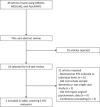Person-centered assessment of apathy and resistance to care in people living with dementia: Review of existing measures
- PMID: 35910667
- PMCID: PMC9322820
- DOI: 10.1002/trc2.12316
Person-centered assessment of apathy and resistance to care in people living with dementia: Review of existing measures
Abstract
Introduction: The review described in this paper builds upon the Dementia Care Practice Recommendations (DCPR) published by the Alzheimer's Association in 2018 and addresses behavior change and the need for targeted outcome measures that evolve from person-centered frameworks and help evaluate interventions. Apathy and resistance to care (RTC) are two specific behavioral expressions of unmet need or distress exhibited by people living with dementia, which are upsetting to formal and family caregivers and compromise quality of life for people living with dementia.
Methods: We conducted literature searches of major databases (PsycInfo, PubMed, EBSCO, CINAHL) for papers examining apathy and RTC constructs in samples of people living with dementia. Reliability and validity coefficients were reviewed and reported, along with examination of whether each measure facilitates contextual understanding of behavior.
Results: Three stand-alone measures of RTC and ten measures of apathy were identified and reviewed. The RTC measures demonstrated good psychometric properties but do not include the perspective of the person living with dementia or contextual aspects of the behavior. The identified apathy measures demonstrated fair to good psychometric properties, and although there is greater consideration of context, none adequately include the perspective of the person living with dementia.
Discussion: Although reliable and valid measures have been developed to measure apathy and RTC in people living with dementia, there is greater need for conceptually driven measurement of behavior context and for tools that elicit and include the perspective of the person living with dementia.
Keywords: apathy; behavioral and psychological symptoms of dementia; challenging behavior; cognitive impairment; dementia; measurement; neuropsychiatric symptoms; resistance to care; unmet needs.
© 2022 The Authors. Alzheimer's & Dementia: Translational Research & Clinical Interventions published by Wiley Periodicals, LLC on behalf of Alzheimer's Association.
Conflict of interest statement
The authors have no conflicts of interest to declare.
Figures
Similar articles
-
Person-centered assessment of people living with dementia: Review of existing measures.Alzheimers Dement (N Y). 2021 May 25;7(1):e12138. doi: 10.1002/trc2.12138. eCollection 2021. Alzheimers Dement (N Y). 2021. PMID: 34095438 Free PMC article.
-
Evaluation of environmental assessment tools for settings for individuals living with dementia.Alzheimers Dement (N Y). 2022 Sep 30;8(1):e12353. doi: 10.1002/trc2.12353. eCollection 2022. Alzheimers Dement (N Y). 2022. PMID: 36204348 Free PMC article.
-
Apathy Measures in Older Adults and People with Dementia: A Systematic Review of Measurement Properties Using the COSMIN Methodology.Dement Geriatr Cogn Disord. 2021;50(2):111-123. doi: 10.1159/000515678. Epub 2021 May 11. Dement Geriatr Cogn Disord. 2021. PMID: 33975314
-
Reliability, validity and relevance of needs assessment instruments for informal dementia caregivers: a psychometric systematic review.JBI Evid Synth. 2020 Apr;18(4):704-742. doi: 10.11124/JBISRIR-2017-003976. JBI Evid Synth. 2020. PMID: 32813339 Free PMC article.
-
Effectiveness of meaningful occupation interventions for people living with dementia in residential aged care: a systematic review.JBI Database System Rev Implement Rep. 2016 Dec;14(12):163-225. doi: 10.11124/JBISRIR-2016-003230. JBI Database System Rev Implement Rep. 2016. PMID: 28009676
Cited by
-
Chatbot-Mediated Learning For Caregiving Relatives of People With Dementia: Empirical Findings and Didactical Implications For Mulitprofessional Health Care.J Multidiscip Healthc. 2024 Jan 16;17:219-228. doi: 10.2147/JMDH.S424790. eCollection 2024. J Multidiscip Healthc. 2024. PMID: 38250309 Free PMC article.
References
-
- Cummings JL. The Neuropsychiatric Inventory: assessing psychopathology in dementia patients. Neurology. 1997;48(5 Suppl 6):S10–S16. - PubMed
LinkOut - more resources
Full Text Sources


